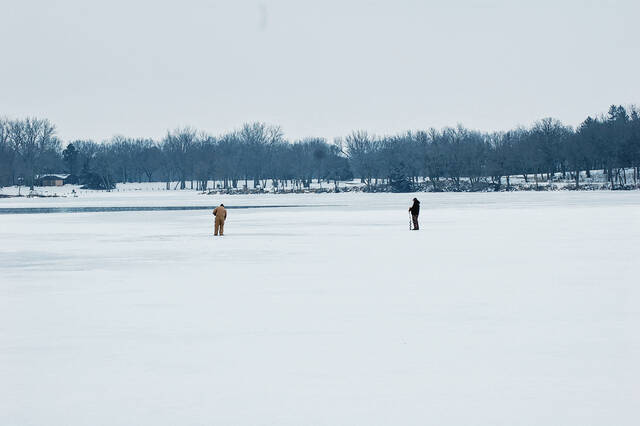
Pictured: Ice fishing is a great way to enjoy the outdoors in the winter. Submitted photo
Submitted photo
The winter weather roller-coaster ride we’ve been on has taken another turn to colder days. As temperatures drop and lakes freeze up once more, ice fishermen will be heading to local waters in search of some fine catches and much needed relief from cabin fever.
Ice fishing offers anglers the opportunity to wet a winter line, while potentially hauling in a mess of great eating fish. If you’ve been searching for a way to spend time outdoors during the remaining frigid days of winter, ice fishing may be just what doctor ordered. Remember though, utmost caution must be applied when heading out onto ice covered waters.
Ice fishing is a great pastime for many reasons, but one of the main reasons I enjoy it so much is because it allows a group to get outside and spend time fishing when most people aren’t even considering the possibility. Ice fishing is a pretty simple endeavor. Only a few tools are necessary, including: an ice auger, a fishing pole, bait and a skimmer. The ice auger is for drilling holes in the ice. Special ice fishing poles are beneficial for fishing close to your hole, but regular old fishing poles will work if you don’t want to invest in special ice fishing gear. Skimmers are simply scoopers for taking chunks of ice of the water inside your drilled out fishing hole.
Ice fishing consists of lowering your offering down through the hole you have augured and working to find the depth fish are holding at. Try dropping your bait all the way to the bottom, and slowly jigging it up and down. If I do not have any strikes, bring in a couple of feet of line, and continue to jig. Fish often are found holding near the bottom, but at times you can find them suspending at different depths.
Depending on what you’re fishing for, baits vary, but the old reliable worms, beemoths, and minnows are favorites of most ice fishermen. Jigs used for ice fishing are small and some savvy ice fishermen will use various fly fishing flies. Some ice anglers choose to fish from a shanty, which is a shelter used to protect from the elements. These are nice for staying warm, put limit scenery and natural exposure.
Ice safety is essential to the enjoyment of ice fishing. Be sure to check the thickness of the ice near the edge of the water you intend to fish. A good rule of thumb is to never fish on ice less than four inches thick. While thinner ice may hold one person, ice thickness varies across a body of water, and you do not want to risk falling through.
Never ice fish alone. Having the assistance of another to pull you to safety if you were to break through is essential. Wear a lifejacket and carry an ice pick or screwdriver in your pocket. The jacket will keep you a float, and the ice pick will allow you to grip the ice and pull yourself out.
Ice fishing can be a ton of fun when a group gets together to spend some time outdoors during the cold winter months. The group I ice fish with likes to build a fire in a barrel on the bank of our local pond. The fire sure is nice for warming our hands after handling a few ice cold bluegills.
See you down the trail.
Brandon Butler writes an outdoors column for The Republic. Send comments to [email protected]. For more Driftwood Outdoors, check out the podcast on www.driftwoodoutdoors.com or anywhere podcasts are streamed.




